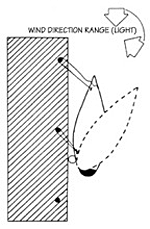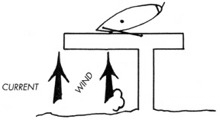Docking Defense
Using forethought and knowledge to look like a pro.
 Here are a few tips that can demystify docking dilemmas. Using good preparation and forethought, as in any aspect of sailing, will create an atmosphere of fun, calm and confidence for your crew.
Here are a few tips that can demystify docking dilemmas. Using good preparation and forethought, as in any aspect of sailing, will create an atmosphere of fun, calm and confidence for your crew.
Prior to leaving the dock, be sure all hands know what to expect. For new crewmembers, be sure they know the lingo. Emphasis that no one releases a dock line without being told so or hearing "cast off". Be sure your commands as skipper are clear. For example, "Cast off the bow line" is a more exact description. Don't forget, just because someone looks like they are listening to you, that may not be the case. After giving departure instructions, ask those new to the environment to repeat what they are going to do. For safety's sake, be sure everyone knows the dangers of getting a limb between the boat and the dock. You will need to decide ahead of time if you are going to bring your lines with you. If so, double them back around the pilings so they can simply be released and pulled aboard.
When it comes time for the actual departure, check wind and current direction. It's usually an easy task to depart when the wind and/or current will pull the boat away from the dock. But if either is keeping you next to the dock, some planning and simple tricks can help. Using a spring line and the engine is the most common solution.
If the wind or current is pushing the boat against the dock, using a line to the stern and springing the bow out is an effective method. Attach a fender to the stern quarter (see illustration), release the bow line and reverse the engine. With a little practice, the boat should pivot around the fender and pull the bow windward away from the dock. Then simply put the engine in forward, remove the stern line and off you go. But take care that you are steering straight and that the stern is not going to swing towards the dock. Of course, when the boat is headed back towards the dock, even more care should be given to the process at hand. Here, the boat is already moving and has to be stopped in a controlled manner in the spot necessary. Again, a prudent skipper will take the time to insure that crewmembers know what to expect. And again, we must look at what the wind and currents are doing to the direction of the boat. But unlike leaving the dock, with an approach, having wind and/or current leading us towards the dock is a good thing... as long as we don't let it dictate where the boat is headed. In this situation, using fenders along the side to cushion the stop and protect the boat is desirable. But remember, the wind has a greater effect on the bow than the stern. The bow will tend to drift down to the dock before the stern; therefore, an approach with the bow slightly towards the wind is a good idea. Keep in mind the stronger the wind is, the greater this force and the higher the angle of on the wind should be.
Of course, when the boat is headed back towards the dock, even more care should be given to the process at hand. Here, the boat is already moving and has to be stopped in a controlled manner in the spot necessary. Again, a prudent skipper will take the time to insure that crewmembers know what to expect. And again, we must look at what the wind and currents are doing to the direction of the boat. But unlike leaving the dock, with an approach, having wind and/or current leading us towards the dock is a good thing... as long as we don't let it dictate where the boat is headed. In this situation, using fenders along the side to cushion the stop and protect the boat is desirable. But remember, the wind has a greater effect on the bow than the stern. The bow will tend to drift down to the dock before the stern; therefore, an approach with the bow slightly towards the wind is a good idea. Keep in mind the stronger the wind is, the greater this force and the higher the angle of on the wind should be. When the wind is going to push you away from the dock, this is the trickiest situation of all. Using some simple techniques will really make you shine. In light wind, simply ensuring that every one knows what to do will allow the boat to be secured to the dock before it is blown down wind. But in higher winds, when the effect is greater, a bow line can be used to grab hold of the dock. Then the stern can be pulled in using the engine. Set the bow line so that it leads aft from the bow to the dock, simply putting the engine in forward and turning the wheel or tiller towards the dock should do the trick (see illustration). Along the same lines, if the bow line leads forward from the boat backing down in reverse may pull the boat's stern towards the dock.
When the wind is going to push you away from the dock, this is the trickiest situation of all. Using some simple techniques will really make you shine. In light wind, simply ensuring that every one knows what to do will allow the boat to be secured to the dock before it is blown down wind. But in higher winds, when the effect is greater, a bow line can be used to grab hold of the dock. Then the stern can be pulled in using the engine. Set the bow line so that it leads aft from the bow to the dock, simply putting the engine in forward and turning the wheel or tiller towards the dock should do the trick (see illustration). Along the same lines, if the bow line leads forward from the boat backing down in reverse may pull the boat's stern towards the dock.
The stern of most boats with inboard engines will pull the stern to port when in reverse. This "prop-walk" effect is due to a few different factors. But simply put, as the blades of the propeller sweep across the lower portion of their circle, they "pull" the boat sideways. For boats with outboard engines, and for those that allow the engine to pivot, using forward or reverse to pull or push the stern in should work well.
Even when the wind is up, a slow, controlled approach to the dock can be used. If the wind is threatening to overtake the boat, just ensure that a bow line can be attached to the dock, stop the boat, and if necessary, use a winch on the stern line to pull the stern in.
Good departure and docking techniques are like a good book or movie, a clear and calm departure sets the tone for the sail. It shows crew and passengers that there is a plan and that everything is in control. Good docking techniques insures the safe operation of your vessel in close-quarters situations and gives your journey a great ending.
Steve Colgate is the founder of Colgate Sailing Schools, with locations in Tortola BVI, Captiva Island FL, Duck Key FL, St. Petersburg FL, Chelsea Piers NY, Liberty Landing NJU and Newport RI.
Offshore Sailing Schools
16731 McGregor Blvd.
Fort Myers, Florida 33908
1-888-454-8002
239-454-1700
Fax: 239-454-1191
e-mail: [email protected]
www.offshore-sailing.com












